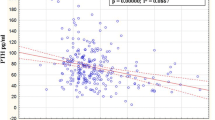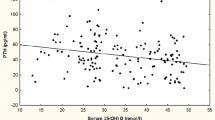Abstract
Summary
This study evaluated the levels of bone turnover markers (BTMs) and investigated relationships between them and bone mineral density (BMD) in postmenopausal women in China suburban district. The prevalence of osteoporosis was 25.03 % at lumbar spine and 6.23 % at femoral neck, and BTMs were negatively correlated with BMDs.
Introduction
The aims of this study were to evaluate the levels of bone turnover markers (BTMs), including serum N-terminal procollagen of type I collagen (P1NP), beta C-terminal cross-linked of type I collagen (β-CTX), 25-hydroxyvitamin D [25(OH)D], and parathyroid hormone (PTH), and to investigate relationships between these markers and bone mineral density (BMD) as well the prevalence of osteoporosis in postmenopausal women of suburban district.
Methods
A population of 4822 postmenopausal women aged 55–69 years old (62.22 ± 6.75) from the suburban district was recruited voluntarily. BMD was measured at the lumbar spine, femoral neck, and total hip using dual-energy X-ray absorptiometry; 2251 women in this group had the serum BTMs 25(OH)D and PTH tested.
Results
The prevalence of osteoporosis was 25.03 % at lumbar spine and 6.23 % at femoral neck. The median (interquartile range) values of serum P1NP, β-CTX, 25(OH)D, and PTH were 59.3 ng/mL (44.7–75.52), 0.370 ng/mL (0.280–0.490), 23.0 ng/mL (17.1–30.5), and 31.4 pg/mL (24.9–39.7), respectively. Serum P1NP and β-CTX levels presented significantly negative correlations with BMDs at the all the sites (Betastd = −0.098 to −0.208, respectively, P < 0.001), whereas PTH levels were negatively correlated with BMDs of the femoral neck and total hip (Betastd = −0.062 and −0.054, P < 0.01, respectively). Serum 25(OH)D had positive associations with BMDs at total hip (Betastd = 0.051, P < 0.01).
Conclusions
The BMD of postmenopausal women in China suburban area is higher than that in downtown area, and over 60 % of the participants had their serum 25(OH)D level over 20 ng/mL. BTMs were negatively correlated with BMDs, suggesting that BTMs are reliable factors for early declines in BMD.


Similar content being viewed by others
References
(1991) Consensus development conference: prophylaxis and treatment of osteoporosis. Osteoporos Int. 1:114–117
Schuit SC, van der Klift M, Weel AE, de Laet CE, Burger H, Seeman E, Hofman A, Uitterlinden AG, van Leeuwen JP, Pols HA (2004) Fracture incidence and association with bone mineral density in elderly men and women: the Rotterdam Study. Bone 34:195–202
Fagerlund KM, Halleen JM (2009) Bone turnover markers and their application in clinical practice. Chin J Osteoporos Bone Miner Res 2:73–78
Singer FR, Eyre DR (2008) Using biochemical markers of bone turnover in clinical practice. Cleve Clin J Med 75:739–750
Kumar R, Thompson JR (2011) The regulation of parathyroid hormone secretion and synthesis. J Am Soc Nephrol 22:216–224
Nakamura K, Saito T, Oyama M, Oshiki R, Kobayashi R, Nishiwaki T, Nashimoto M, Tsuchiya Y (2011) Vitamin D sufficiency is associated with low incidence of limb and vertebral fractures in community-dwelling elderly Japanese women: the Muramatsu Study. Osteoporos Int 22:97–103
Shanghai Municipal Statistics Bureau, Survey Office of the National Bureau of Statistics in Shanghai (2015) Shanghai Statistical Yearbook 2014. Shanghai
Shanghai Pudong New Area Statistics Bureau, Pudong Survey Team of National Statistics Bureau (2015) Shanghai Pudong New Area Statistical Yearbook 2014. Shanghai
Huang QR, Zhou Q, Lu JH, Hu YQ, Liu YJ, Qin YJ, Ma JX, Li M (2002) Bone mineral density and age-related bone loss in 2111 healthy women in Shanghai. Chin J Osteoporos 8:191–194
Zhang H, Shan PF, Luo XH, Wu XP, Liao EY (2006) Prospective investigation of annual bone loss rate in females in Changsha city, Hunan province. Zhonghua yi xue za zhi 86:2986–2989
Hou YL, Liao EY, Wu XP, Peng YQ, Zhang H, Dai RC, Luo XH, Cao XZ (2008) Effects of the sample size of reference population on determining BMD reference curve and peak BMD and diagnosing osteoporosis. Osteoporos Int 19:71–78
Cheng Q, Zhao XY, Zhang XM, Li HL, Du YP, Zhu HM (2012) Age and sex effects on the association between body composition and bone mineral density in healthy Chinese men and women. Menopause (New York, NY) 19:448–55
Martin Jimenez JA, Consuegra Moya B, Martin Jimenez MT (2015) [Nutritional factors in preventing osteoporosis]. Nutr Hosp 32 Suppl 1:49–55
Zhou XW, Wu XY, Luo L, Guo LJ, Lei MX, Zhang H, Xie H, Peng YQ, Wu XP, Liao EY (2011) The relationship between bone turnover markers and BMD decreasing rates in Chinese middle-aged women. Clin Chim Acta 412:1648–1657
Lu HK, Zhang Z, Ke YH, He JW, Fu WZ, Zhang CQ, Zhang ZL (2012) High prevalence of vitamin D insufficiency in China: relationship with the levels of parathyroid hormone and markers of bone turnover. PLoS One 7:e47264
Song BB, Wu J, Zhang CY, Jin J, Zhu J, Guo W, Pan BS (2009) Serum bone turnover markers reference intervals establishment in population of Shanghai. Chin J Lab Med 32:1161–65
Zhao J, Xia W, Nie M et al (2011) The levels of bone turnover markers in Chinese postmenopausal women: Peking Vertebral Fracture study. Menopause (New York, NY) 18:1237–1243
Hu WW, Zhang Z, He JW, Fu WZ, Wang C, Zhang H, Yue H, Gu JM, Zhang ZL (2013) Establishing reference intervals for bone turnover markers in the healthy Shanghai population and the relationship with bone mineral density in postmenopausal women. Int J Endocrinol 2013:513925
Martinez J, Olmos JM, Hernandez JL, Pinedo G, Llorca J, Obregon E, Valero C, Gonzalez-Macias J (2009) Bone turnover markers in Spanish postmenopausal women: the Camargo cohort study. Clin Chim Acta 409:70–74
Boudou P, Ibrahim F, Cormier C, Sarfati E, Souberbielle JC (2009) Potential utility of high preoperative levels of serum type I collagen markers in postmenopausal women with primary hyperparathyroidism with respect to their short-term variations after parathyroidectomy. J Bone Miner Metab 27:240–246
Al-Daghri NM, Yakout S, Al-Shehri E, Al-Fawaz HA, Aljohani N, Al-Saleh Y (2014) Inflammatory and bone turnover markers in relation to PTH and vitamin D status among Saudi postmenopausal women with and without osteoporosis. Int J Clin Exp 7:3528–3535
Garnero P, Munoz F, Sornay-Rendu E, Delmas PD (2007) Associations of vitamin D status with bone mineral density, bone turnover, bone loss and fracture risk in healthy postmenopausal women. The OFELY study. Bone 40:716–722
Dawson-Hughes B, Harris SS, Krall EA, Dallal GE, Falconer G, Green CL (1995) Rates of bone loss in postmenopausal women randomly assigned to one of two dosages of vitamin D. Am J Clin Nutr 61:1140–1145
Hunter D, Major P, Arden N, Swaminathan R, Andrew T, MacGregor AJ, Keen R, Snieder H, Spector TD (2000) A randomized controlled trial of vitamin D supplementation on preventing postmenopausal bone loss and modifying bone metabolism using identical twin pairs. J Bone Miner Metab 15:2276–2283
Ooms ME, Roos JC, Bezemer PD, van der Vijgh WJ, Bouter LM, Lips P (1995) Prevention of bone loss by vitamin D supplementation in elderly women: a randomized double-blind trial. J Clin Endocrinol Metab 80:1052–1058
Sahota O, Masud T, San P, Hosking DJ (1999) Vitamin D insufficiency increases bone turnover markers and enhances bone loss at the hip in patients with established vertebral osteoporosis. Clin Endocrinol (Oxf) 51:217–221
Scharla SH, Scheidt-Nave C, Leidig G, Woitge H, Wuster C, Seibel MJ, Ziegler R (1996) Lower serum 25-hydroxyvitamin D is associated with increased bone resorption markers and lower bone density at the proximal femur in normal females: a population-based study. Exp Clin Endocrinol Diabetes 104:289–292
Kuchuk NO, van Schoor NM, Pluijm SM, Chines A, Lips P (2009) Vitamin D status, parathyroid function, bone turnover, and BMD in postmenopausal women with osteoporosis: global perspective. J Bone Miner Res 24:693–701
Garnero P, Hausherr E, Chapuy MC, Marcelli C, Grandjean H, Muller C, Cormier C, Breart G, Meunier PJ, Delmas PD (1996) Markers of bone resorption predict hip fracture in elderly women: the EPIDOS Prospective Study. J Bone Miner Res 11:1531–1538
Melton LJ 3rd, Khosla S, Atkinson EJ, O’Fallon WM, Riggs BL (1997) Relationship of bone turnover to bone density and fractures. J Bone Miner Res 12:1083–1091
von Muhlen DG, Greendale GA, Garland CF, Wan L, Barrett-Connor E (2005) Vitamin D, parathyroid hormone levels and bone mineral density in community-dwelling older women: the Rancho Bernardo Study. Osteoporos Int 16:1721–1726
Mezquita-Raya P, Munoz-Torres M, Luna JD, Luna V, Lopez-Rodriguez F, Torres-Vela E, Escobar-Jimenez F (2001) Relation between vitamin D insufficiency, bone density, and bone metabolism in healthy postmenopausal women. J Bone Miner Res 16:1408–1415
Nakamura K, Tsugawa N, Saito T et al (2008) Vitamin D status, bone mass, and bone metabolism in home-dwelling postmenopausal Japanese women: Yokogoshi Study. Bone 42:271–277
Arabi A, Baddoura R, El-Rassi R, El-Hajj Fuleihan G (2012) PTH level but not 25 (OH) vitamin D level predicts bone loss rates in the elderly. Osteoporos Int 23:971–980
Acknowledgments
The authors acknowledge the excellent assistance of Shan-Shan Li and Wei-Jia Yu with data collection and import. This study was supported by a research grant from the Shanghai Hospital Development Center (SHDC12013115) and Drug Innovation Program of the National Science and Technology Project (2011ZX09307-001-02). The authors would like to thank all of the patients who participated in this study.
Author information
Authors and Affiliations
Corresponding author
Ethics declarations
Conflicts of interest
None.
Electronic supplementary material
Below is the link to the electronic supplementary material.
Supplementary Table 1
(DOCX 16 kb)
Supplementary Table 2
(DOCX 17 kb)
Supplementary Table 3
(DOCX 17 kb)
Rights and permissions
About this article
Cite this article
Gao, C., Qiao, J., Li, S.S. et al. The levels of bone turnover markers 25(OH)D and PTH and their relationship with bone mineral density in postmenopausal women in a suburban district in China. Osteoporos Int 28, 211–218 (2017). https://doi.org/10.1007/s00198-016-3692-6
Received:
Accepted:
Published:
Issue Date:
DOI: https://doi.org/10.1007/s00198-016-3692-6




